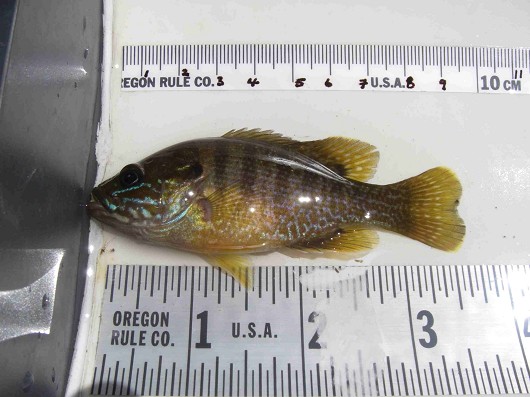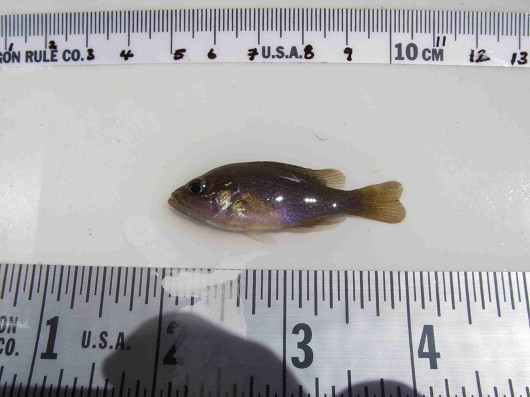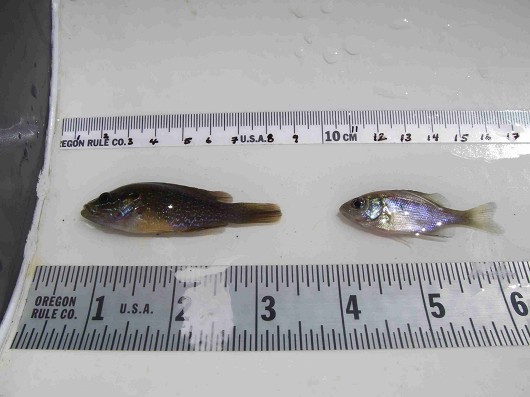Green Sunfish
-
Scientific NameLepomis cyanellus
-
NativeNon-Native
-
Identification
 Green sunfish with measurements Location: Leonard Lake, California Date: 8/6/2008 Photo: Lisa Thompson
Green sunfish with measurements Location: Leonard Lake, California Date: 8/6/2008 Photo: Lisa Thompson Green sunfish with measurements Location: Leonard Lake, California Date: 8/6/2008
Green sunfish with measurements Location: Leonard Lake, California Date: 8/6/2008 Green sunfish and bluegill with measurements Location: Leonard Lake, California Date: 8/6/2008 Photo: Lisa Thompson
Green sunfish and bluegill with measurements Location: Leonard Lake, California Date: 8/6/2008 Photo: Lisa Thompson- Very stout and slightly deep body
- Rounded pectoral fins
- Larger terminal mouth has maxillae that extend past the front margin of the eye
- Short stiff opercular flaps
- 10-12 dorsal, 8-10 anal, 5 pelvic, and 13-15 pectoral fin rays
- 9-11 dorsal, 3 anal, and 1 pelvic spine(s)
- Dark olive on back becoming lighter on the sides, often with iridescent green flecks and colored stripes
- Yellow-orange breast and belly, iridescent green stripes on the cheek
- Dorsal and anal fins have a dark blotch on their soft-rayed portion
- Young show fine, closely spaced chains of iridescent blue green grid
- Back, sides, and fins of breeding males turn dark along with yellow margins on the fins
-
Life History
Green sunfish are most common in small, warm streams with turbid, mud-bottom pools and aquatic vegetation, and are especially prevalent in streams that are intermittent in summer. They can also be found in ponds and large lakes in shallow weedy areas that are ill-suited to larger predators. This is important because green sunfish tend to do very poorly in areas with multiple fish species, especially bass. In contrast, areas that are disturbed and inhospitable to less tolerant fish support a community dominated by the green sunfish. They will often be found in small populations in deep, bedrock-lined pools of undisturbed streams, poised to invade the channel itself if the habitat is altered. This ability to thrive in disturbed streams is aided by their tolerance of temperatures greater than 38°C, dissolved oxygen levels less than 1 mg/L and alkalinities up to 2,000 mg/L. Their one major restriction seems to come from salinity as they avoid waters with salinity greater than 1-2 ppt. They are also an aggressive species with territorial feeding ranges that continually force young green sunfish into new areas. They are opportunistic predators, feeding primarily on invertebrates and small fish. Young of the year feed mainly on zooplankton, small benthic invertebrates, and the larvae of other fish, but, as they grow, the focus of their diet switches towards large aquatic and terrestrial insects, crayfish, and other fish.
Green sunfish mature at the beginning of their third year when they reach approximately 5-7 cm in length. Mating occurs between May and August, with the most prolific period in May and June. The preferred spawning areas are 4-50 cm deep with fine gravel bottoms near overhanging bushes or other cover. Here males will construct nests 15-38 cm in diameter while females circle the area in schools. When one is ready to spawn she will descend towards the nests and a group of males will begin courting her immediately. Once a male is selected the pair will return to his nest for a mating ritual where the female turns on her side to release eggs while the male remains upright. This creates a position where the male is perpendicular to the female, connected near their genital openings, so that the eggs can be fertilized as they are released. Both sexes have multiple mates with each female capable of laying 2,000-10,000 eggs a season depending on her size.
Fertilized eggs adhere to the substrate of the nest where the male will guard them for 5-7 days, at which point the eggs have hatched and the offspring have become free swimming. These young fish will be planktonic for a few days before settling into the local vegetation. They will grow to 3-5 cm in their first year and 8-13 cm SL by their third year. Green sunfish can live to be 10 years old and as long as 30 cm but this only occurs under optimal, less competitive conditions; many 4-5 year old fish only measure 8-10 cm.
-
Links to Other ResearchN / A
-
WatershedN / A
Please note, watersheds are at the USGS 8-digit Hydrologic Unit Code (HUC) scale, so they often include a lot of sub-watersheds. If a species occurs in any sub-watershed within the HUC, the species appears within the HUC. Link to an EPA page that shows HUCs.


